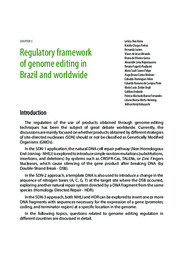Regulatory framework of genome editing in Brazil and worldwide.
Regulatory framework of genome editing in Brazil and worldwide.
Author(s): VIEIRA, L. R.; FREITAS, N. C.; JUSTEN, F.; MIRANDA, V. de J.; GARCIA, B. de O.; NEPOMUCENO, A. L.; FUGANTI-PAGLIARINI, R.; FELIPE, M. S. S.; MOLINARI, H. B. C.; VELINI, E. D.; PINTO, E. R. de C.; DAGLI, M. L. Z.; ANDRADE, G.; FERNANDES, P. M. B.; MERTZ-HENNING, L. M.; KOBAYASHI, A. K.
Summary: The regulation of the use of products obtained through genome-editing techniques has been the subject of great debate worldwide. Currently, the discussions are mainly focused on whether products obtained by different strategies of site-directed nucleases (SDN) should or not be classified as Genetically Modified Organisms (GMOs). In the SDN-1 application, the natural DNA cell repair pathway (Non-Homologous End-Joining - NHEJ) is explored to introduce simple random mutations (substitutions, insertions, and deletions) by systems such as CRISPR-Cas, TALENs, or Zinc Fingers Nucleases, which cause silencing of the gene product after breaking DNA (by Double-Strand Break - DSB). In the SDN-2 approach, a template DNA is also used to introduce a change in the sequence of nitrogen bases (A, C, G, T) at the target site where the DSB occurred, exploring another natural repair system directed by a DNA fragment from the same species (Homology-Directed Repair - HDR). In the SDN-3 approach, both NHEJ and HDR can be explored to insert one or more DNA fragments with sequences necessary for the expression of a gene (promoter, coding, and terminator region) at a specific location in the genome. In the following topics, questions related to genome editing regulation in different countries are discussed in detail.
Publication year: 2021
Types of publication: Book sections
Unit: Embrapa Soybean
Observation
Some of Embrapa's publications are published as ePub files. To read them, use or download one of the following free software options to your computer or mobile device. Android: Google Play Books; IOS: iBooks; Windows and Linux: Calibre.
Access other publications
Access the Agricultural Research Database (BDPA) to consult Embrapa's full library collection and records.
Visit Embrapa Bookstore to purchase books and other publications sold by Embrapa.

